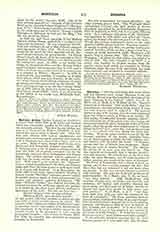

Hortulus Animae (LITTLE GARDEN OF THE SOUL), a prayer book which both in its Latin and German forms was exceedingly popular in the early years of the sixteenth century. The first known edition was printed at Strasburg by William Schaffener of Rappoltsweiler, and is dated March 13, 1498. After that date new editions with various supplements and modifications were constantly issued by other printers both in Strasburg and other German cities, and even at Lyons. Many of them, though small in size, were illustrated with beautifully designed woodcuts. Mr. C. Dodgson gives a list of eighteen editions between 1516 and 1521, all of which contained cuts by the well-known engravers Hans Springinklee and Erhard SchSn. The earliest German edition appeared in 1501, but the Latin editions on the whole predominate. With regard to its contents, the “Hortulus” bears a general resemblance to the Horne and Primers which were then the form of prayer book most familiar in France and England. As in these latter, the Little Office of our Lady always occupies the place of honor, but the “Hortulus” contains a greater variety of popular prayers, many of them recommended by curious and probably spurious Indulgences. The name “Hortulus Animas” was derived not from the aesthetic but from the utilitarian aspects of a garden, as is shown by the three Latin distichs prefixed to most copies of the work. The first two lines run:
Ortulus exiguus varias ut saepe salubres
Herbas producit, quas medicina probat.
(A tiny garden will often produce a variety of salutary herbs of which medicine knows the value). The contents of the volume are further described as “mentis pharmaca sacrie” (the simples of the devout mind). The popularity of the book is further shown by the extreme beauty of the miniatures in some existing manuscript examples. One of these at Vienna (Bibl. Pal. 2706) has recently been produced in exquisite facsimile by Dornhoffer.
The title in particular was found attractive. Another German prayer book, “Das Wurtzgart Linder andachtigen Uebung” (the herb garden of devout practices) was edited by an Observantine Franciscan friar at Augsburg in 1513, but it is a quite different work. So a Lutheran adaptation of the “Hortulus” was produced in 1569 which was called the “Lustgarten der Seelen” (the pleasure garden of the soul)—though this perhaps corresponds better to the other famous Catholic prayer book the “Paradisus Animae”. It should be noted also that yet another well-known work of devotion, which was not a prayer book but a volume of moral instruction richly illustrated with stories, bore a similar title. This was “Der Selen Wurtzgart,” of which the first edition was printed at Ulm in 1483. The title, “Garden of the Soul“, is of course very familiar to English readers from the popular prayer book which was compiled by Bishop Challoner about the year 1740, and which has since been reprinted and reedited in countless editions.
HERBERT THURSTON

